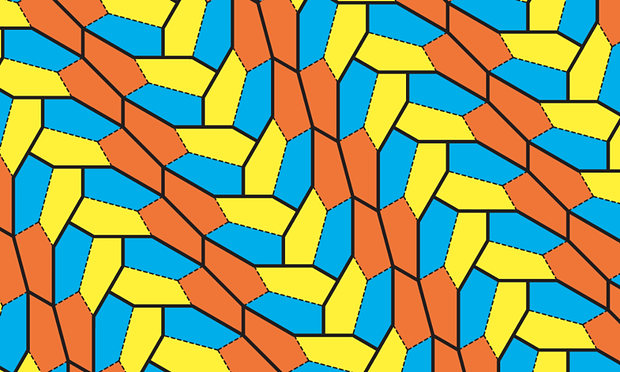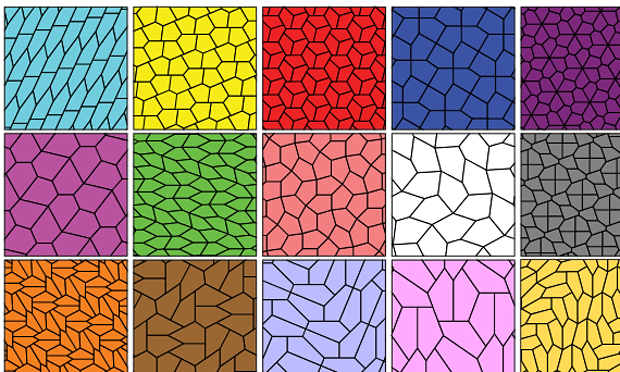Alex Bellos gives us exciting news from the world of mathematics of the discovery of a new pentagonal shape that has the ability to “tile the plane”. i.e., to cover a flat surface using only that shape, leaving no gaps. Here it is.
All triangles and quadrilaterals can tile the plane and “It was proved in 1963 that there are exactly three types of convex hexagon that tile the plane. And no convex heptagon, octagon, or anything else-gon tiles the plane.” It turns out that pentagons are the only shape for which the number that can tile a plane is as yet unknown. Not all pentagons can tile the plane, and the familiar regular symmetric pentagon is an example of one that does not.
The search for the exhaustive list of these pentagonal tiles is quite fascinating. After five were discovered by German mathematician Karl Reinhardt in 1918, R. B. Kershner added three more in 1968, and Richard James added another in 1975. Then in the next few years an amateur, a San Diego woman in her 50s named Marjorie Rice who had came across an article in Scientific American about James’s discovery, added four more. (Her story can be read here.) Rolf Stein in 1985 found a 14th one and then things remained dormant until the most recent one was announced last month by Casey Mann, Jennifer McLoud and David Von Derau of the University of Washington Bothell.
So here is the current list of 15.
So how many possible pentagons are there that can tile the floor? This may be one of those problems, like the four-color map, that defies a clean analytical solution and we may need a computer-assisted proof in order to get a definitive answer.



I would argue that the top row leftmost is just a special case of the middle row leftmost. In both cases, they start with a tile pattern of hexagons, that are then broken into 2 pentagons each by drawing a new line that passes through the center of the hexagon. The top pattern happens to have that line be at right angles to the 2 long sides of the hexagon, but any angle that allows the new line to touch both of the long sides as well as the center point will work.
Also, the bottom row leftmost seems to be toplogically the same as the one to its right. Probably many more of these patterns are the same, toplogically speaking.
Slightly annoyed that the image isn’t a complete tile -- It would make a good desktop background otherwise.
It looks like there is enough to construct a full tile by copying in Photoshop/The Gimp/etc. It would also let you set the colours to something a bit more pleasing to the eye.
At first glance, the white tessellation, fourth on the middle row, doesn’t appear to have a visible, repetitive patterns. If there were many more tiles, you would see interlocking sets of threes.
Pretty much any shape can be tessellated. The most important point is repeated surrounding symmetry around the centre of the shape. This site lets you create them with click-and-drag:
http://www.shodor.org/interactivate/activities/Tessellate/
M.C. Escher’s tessellations remain some of the most creative.
https://www.originsonline.org/sites/default/files/images/approach/gecko_tessellation.jpg
@1: The apparently-equivalent tilings can be distinguished if you look at the transformations/orientations of the pentagons. In the top-left pattern, the pentagons appear in only two orientations, while in the middle-left there are four. (And the pentagons in the top-left don’t have any symmetry by which you could argue that the two orientations there are equivalent to four.)
The bottom-left and bottom-second-from-left are harder to distinguish. Both have similar patterns of groups of four interlocking pentagons, meeting “teeth to teeth.” In each, two different orientations of this larger pattern give a total of eight orientations for the base pentagon. However, in the bottom-left pattern, all the patterns of four, in either orientation, run from top-left to bottom-right. In the bottom-second-from-left, one pattern runs from top-left to bottom-right ant the other from top-right to bottom-left. Therefore, no amount of stretching, rotating, or sliding could turn one of those patterns into the other, you’d actually have to rearrange the pieces.
(This would be much easier to explain with pictures.)
The new pentagonal tiling only works if non-equivalent enantiomorphs (reflections that cannot be superimposed) are allowed -- also true of some of the others. A related problem I spent some time on, but did not get far with, is which shapes can be constructed out of smaller copies of themselves, no two being the same size (I did not allow reflections). One of Martin Gardner’s “Mathematical Games” columns in Scientific American dealt with the case of the square. Somewhere I have an unpublished and unchecked proof that there is no polygon which can be divided into two unequal copies of itself (if reflections are allowed, however, any right-angled triangle can be so divided), and exactly one convex polygon that can be divided into three unequal copies of itself (again, not allowing reflections).
To clarify (5), the smaller copies must be superimposable on the original by magnification and translation, without reflection.
I knew it wouldn’t be correct, but the title first made me think of something else entirely.